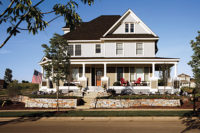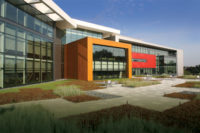While it’s true that water, wind and ice pose significant challenges to any structural design, building science has come a long way in the defense against these elements and their potential to cause mold, rot and decay. When it comes to constructing high-performance building envelopes, there are a growing number of products architects and specifiers can choose from to create rainscreens and protect their building’s aesthetic and structural integrity. That’s why it's so important to understand thoroughly how these various materials can stand up to Mother Nature’s worst and protect the health and energy efficiency of the interior environment for occupants.
The Case for Moisture Management
The American Society for Testing Materials reports that “about 90 percent of all building problems are associated with water in some way.” This statistic highlights the need for deliberate and comprehensive moisture management strategies for exterior wall assemblies and products that can stand up to the elements.
Most moisture management strategies begin by carefully considering control measures to mitigate the intrusion of moisture. It is important, however, to analyze the various states of moisture (liquid, ice and vapor), as well as all the areas where it can infiltrate the building envelope and adopt strategies and materials that accommodate all of them.
The four major transport mechanisms of moisture into the building envelope are wind-driven precipitation, water vapor in the air (including interior air), built-in or stored moisture, and liquid-bound groundwater driven by capillary action and gravity. Other drivers include gravity, pressure differential, stack effect, air leakage and the location of building components in the building envelope. Keep in mind that there could be competing strategies for managing these that create new problems, such as trapped moisture, and these must be avoided.
Rainscreens are typically recommended for areas that receive at least 40 inches of rain per year but rainscreens add value in all geographic areas by mitigating the risk of moisture intrusion, thereby creating a high-performing exterior wall assembly.
Ultimately, the key to effective moisture management is to limit the moisture penetration as soon as possible and then provide an easy escape route for any moisture that gets into the building envelope. This includes making sure windows have proper flashings, checking wall intersections with the roofline, ensuring walls can drain bulk water, and installing adequate air and vapor barriers. From a cladding perspective, a rainscreen assembly is a practical option to achieve a high-performing building envelope.
Understanding Rainscreens
A rainscreen wall is an exterior wall system where the visible wall cladding acts as the primary moisture barrier and stands off from the second moisture-resistant surface applied to the sheathing. This arrangement creates a capillary break and allows drainage, evaporation and drying of moisture that penetrates the cladding and becomes trapped in the wall.
Rainscreens are typically recommended for areas that receive at least 40 inches of rain per year, but rainscreens add value in all geographic areas by mitigating the risk of moisture intrusion, thereby creating a high-performing exterior wall assembly.
Rainscreen walls offer two lines of defense against moisture penetration into the building envelope: 1.) minimizing moisture passage into the wall cavity while also managing the driving forces acting on the wall, and 2.) intercepting all water that gets past the first line of defense and effectively dissipating it back to the exterior. This is achieved through the interaction of four basic components, each designed to complement the functions of the others.
1. Exterior Cladding: As the outermost component of the rainscreen system, exterior cladding takes the greatest velocity and volume of moisture. Depending on the material and construction details, some water may pass through this layer in much lower volumes and at a reduced velocity.
2. Air Gap: The next component is the air gap behind the exterior cladding. This gap, sometimes referred to as the channel or drainage cavity, must be ventilated at both the top and bottom. Its primary function is to provide the escape route for any moisture or water that passes through the outer cladding or is trapped within the interior wall or assembly. This is achieved with furring strips, drainage mats, or even some weather-resistant barriers that provide integrated drainage technology. Typically, a minimum 3/8-inch cavity is recommended for efficient drainage.
3. Weather-resistive Barrier: Next in line is the weather-resistive barrier, or WRB. The 2018 IBC section 1402.2 states that exterior walls must provide the building with a weather-resistant exterior wall envelope. The design and construction of the exterior wall must include a water-resistive barrier behind the exterior veneer that prevents the accumulation of moisture within the wall assembly.
For a drainage plane to be effective, it must be continuous and integrated with flashings. The most common material for this layer is house wrap, which resists the penetration of water from the exterior into the interior sheathing, but also allows the passage of vapor and trapped moisture from the interior into the gap. A WRB also functions as an air barrier and prevents external air from passing through the envelope into the interior. Building felts, various troweled materials, and foam insulators could also be used for this layer. The capacity of this layer compensates for any inadequacies in the cladding layer. In an ideal system, this layer never gets wet, but in the worst case, it should only have a small amount of moisture under low pressure to deal with.
4. Flashing: The final component is flashing, thin pieces of impervious metal installed over openings in the wall, around the inside and outside corners, and where cladding styles change to prevent the passage of water into the structure. Flashing is intended to direct water collecting on the drainage plane to the outside of the cladding. Additionally, flashing helps to prevent water penetration at windows, doors, vents, pipes, chimneys and other openings to make a building more durable and reduce or prevent moisture management problems. Flashings must be carefully sealed into the WRB to function properly. Metal flashings include aluminum, copper, stainless steel and galvanized metals.
Rainscreen Cladding Options
There are many options for rainscreen cladding, and the individual performance of each varies. It’s important to classify materials into two different groups as it relates to how they handle moisture—hydroscopic and hydrophobic.
Hydroscopic materials absorb water, and most traditional building materials such as wood, concrete, brick and plaster fall into this category. Hydrophobic materials repel water. Examples include glass, metals and plastics—including wood-plastic composites. Some materials exhibit hybrid behavior, such as water-resistive barriers, house wraps and building felts, that can resist bulk water but freely allow vapor diffusion.
While brick, wood and stone are all beautiful, their hydroscopic nature puts them at risk for moisture-related issues down the road—especially if installed incorrectly.
Materials that are less vulnerable to water are gaining popularity among construction teams looking for high-performing, aesthetically pleasing sustainable products. This category includes metal cladding options like galvanized steel, aluminum and copper, which are recognized for their ease of maintenance. Another compelling option is wood-plastic composite cladding. Designed to emulate real wood, composite cladding is resistant to many natural forces that can compromise the beauty and performance of other types of cladding. And unlike wood, WPC products are priced competitively and cost less than most rainforest wood cladding or engineered cladding products.
A Closer Look at Wood-Plastic Composites
The popularity of wood-plastic composites has increased substantially year over year, with the material quickly becoming the cladding material of choice for architects due to its performance characteristics, sustainable construction, durability and life-cycle attributes.
From a performance point of view, wood-plastic composites are hard to beat. Their durable composite core ensures exceptional resistance to rotting, cracking, insects and decay. Additionally, the material never needs sanding, staining or painting, making it perfect for difficult-to-reach applications. Unlike wood and stone, wood-plastic composite cladding deflects the water it encounters. What’s more, it resists fading due to sun exposure and is not affected by freeze-thaw cycles. When installed correctly, wood-plastic composite rainscreen cladding is a terrific option for a low-maintenance, aesthetically pleasing façade.
Design Benefits of Wood-Plastic Composite
In addition to the material’s performance and sustainability characteristics, project teams are turning to wood-plastic composites for their unique design aesthetics. For a new Starbucks in Pell City, Alabama, the owner was interested in a dynamic, mixed-wood design for the building’s exterior that would fit the upscale, modern aesthetic of other businesses in the area. Worried that wood wouldn’t be able to maintain its appearance or performance over time, general contractor Jonathon Seay, president of Seay Construction Inc., recommended composite cladding knowing it would achieve this look without sacrificing anything in terms of durability and performance.
“Not using a real wood product was appealing to us because no matter how well you install [authentic wood], if the product is failing in a year or two, that makes us look bad,” Seay said. “With composites, once you properly install it, the owner never has to worry about it again.”
It’s no secret that entrapped moisture can create major problems in the building envelope. There is considerable evidence that moisture—rain, in particular—can be extremely destructive to building envelopes and interiors, and managing this moisture is critical to building durability and occupants’ health. A parallel body of evidence demonstrates that rainscreen walls are highly effective in managing moisture and ensuring the durability and integrity of building envelopes.
Thankfully, there are options when it comes to selecting the right rainscreen cladding material. Specifiers no longer must choose between form and function. As with the Starbucks project team, building pros can achieve an organic, timeless look with none of the upkeep or vulnerability that comes with traditional materials. New technology like wood-plastic composite siding means that architects can achieve the impossible feat—a building that looks and feels forever young.






Report Abusive Comment